Overview
As the term explains, Product development refers to the process of delivering completely new products or services in the existing markets. But, do you know that product development is an inexorable part of the product development lifecycle? Have you ever thought of the different strategies connected to new product development? Obviously No! But, we need to consider the fact that the organizations undertake different strategies to prevent bad products from being launched in the market.
Table of Content
"No amount of tools can help a bad product. You have to remain genuine in your product development innovation and quality." - Kara Swisher
In this expedient blog, we will help you understand in detail the strategies and tactics of product development with a plethora of examples. The blog discusses the stages of product development as well the characteristics of successful product development to help you understand the product development component of the Ansoff matrix in detail.
What is a product development strategy?
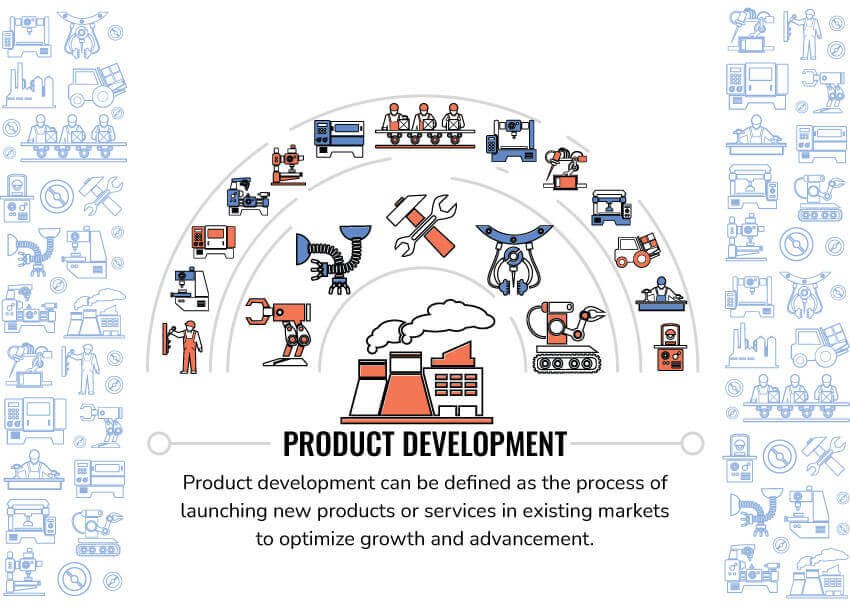
New products emerge in the market at a rapid pace with the launch of new products by one or the other organizations. Product development strategy refers to the process of bringing new products or innovations to existing customers. It includes the set of actions, strategies, and tactics being adopted by the organizations with the aim to bring new products or services in the existing market. You must have been wondering that new product development is one of the easiest strategies to understand. But, do you know that this growth strategy also requires a significant change in the business operations. This growth strategy is adopted by the firms through extensive research and development on the current markets, existing products, customer needs, etc.
Product development strategies
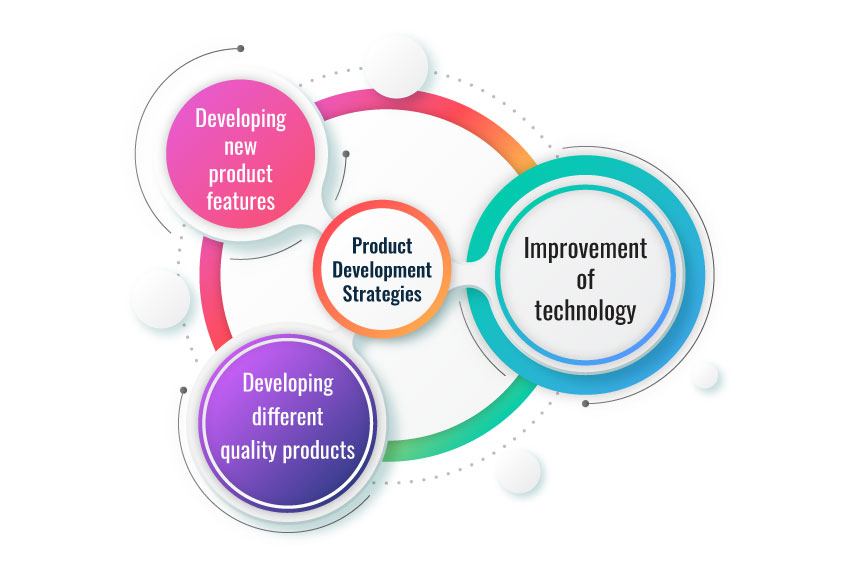
We all know that selling products that meet the needs of a large group of customers helps to generate huge business sales. But, what are the main strategies that the organizations adopt to launch new products in the market? Let’s have a look at some of the strategies that the companies use to develop new and innovate existing products.
Developing new product features
One of the important strategies that can be used by organizations in developing new product features. This strategy was also used by Samsung while launching Samsung S5. Samsung added more RAM and processing power by upgrading the software. Also, Galaxy S5 was introduced with the fingerprint sensor on the front of the phone whereas Samsung Galaxy S4 didn’t have this feature. Not just this, the Galaxy S5 also has a rear camera of 16 Megapixels with the capability of 4K video recording.
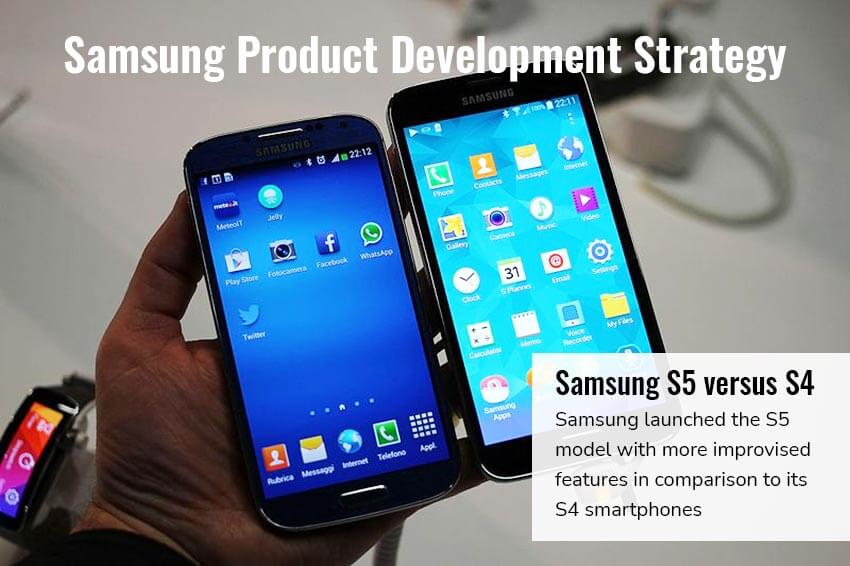
Improvement of technology
The other key strategy that most of the organizations adopt in the current times is technological advancement in the products. We also know that innovation is one of the key factors considered by the customers while buying new products and services. Levi’s commuter Trucker Jacket is one of the major clothing innovations being undertaken by Levi’s by building up sensitive areas on jacket sleeves. The jacket features a variety of services including music and map apps to smarten up the commute in a number of ways.

Develop different quality products
The other important strategy that is adopted by the organizations is developing high-quality products in the market. An example of this strategy is Starbucks VIA™ Ready Brew as some instant coffee uses lower quality coffee beans and adds Chemicals as well as by-products in the coffee whereas Starbucks Ready Brew is 100% naturally roasted coffee that is made without adding any preservatives. The patent-pending technology is also used to preserve the coffee taste quality as well as freshness.

Product development tactics
Now, we have discussed the strategies for the new product launch in the previous section but do you think that strategies and tactics are different concepts? You can read our strategy and Tactics blog for a better understanding. There are different tactics that can be used for the implementation of the new product development strategy.
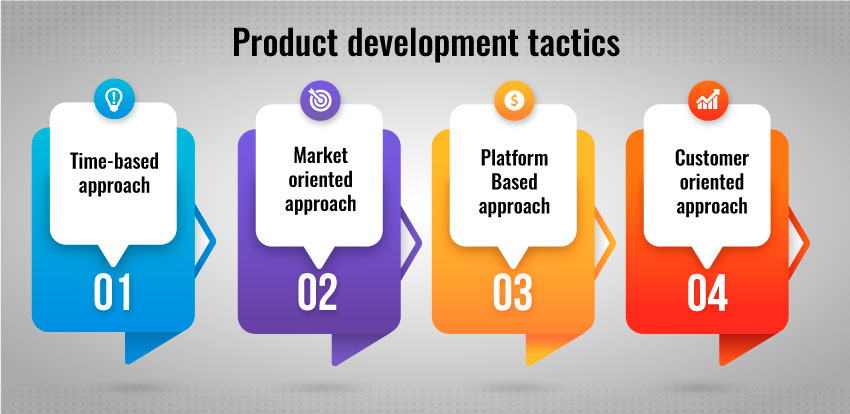
Time-based approach
One of the important tactics to product development is a time-based approach which considers the time when the new product is launched in the market. The time-based approach focuses on the three different product development strategies that can be used by the organization. These include first to the market, laggard, and fast follower. The companies that launch products first to the market reap big benefits and rewards by attracting huge popularity and customer focus.
The best example of a time-based approach is Amazon that attained a first-mover advantage in the e-Commerce sector. Amazon attained a first-mover advantage in two different ways that are by partnering with borders and extending their product offering into apparel, toys, electronics, and housewares.
Market-oriented approach
The important product development tactic that can be used by the organization is a market-oriented approach that revolves around the dimensions of the target market. In this strategy, the organization focuses on identifying the needs of the customer and creating products and services that best satisfy them.
Kellogg’s is the world’s leading cereal company that manufactures various cereal and convenience food items such as cookies, frozen waffles, and crackers. The company launches new products in the market by considering the customer’s needs and wants. Kellogg’s uses the social media marketing strategy to procure customer feedback on social media platforms and to inform customers about its product road map.
Platform-Based approach
Platform-based approach is another important tactic for new product development that can be used by the organization by facilitating the collection of assets that can be shared among different products. The platform-based approach can be used by the organization by engaging in research and development practices for many years and investing all efforts from one or more innovative concepts. The main benefit of the platform-based approach is that organizations can attain maximum revenue by reducing the cost associated with the new product offerings.
For instance, the HP Helion development platform helps to accelerate the development of hybrid cloud applications through open and interoperable platforms. The platform-based approach enables HP to rapidly develop cloud-native applications by using best-in-class developer tools.
Customer-oriented approach
Customer-oriented approach is one of the important product development tactics that can be used by the organization to develop new products by focusing on the customer needs. In this approach, the organization uses a design thinking approach to deeply understand the customer needs and then convert the information into successful product launches. The main focus of this approach is not on what competitors are doing but mainly focuses on the needs of the customers. Further, this approach is also known as the Agile product development approach that puts a higher focus on the customer needs while engaging in product planning, designing, concept mapping, engineering, and manufacturing processes.
Do you know any examples of this approach? Oral-B electric toothbrush is also launched by using a design thinking approach where Oral-B hired Kim Colin and Sam Hecht as the designers for its product. The main focus while developing the electric toothbrush was on understanding the customer’s experience. As a result, the USB charging system was added to the brushes to enable the customers to easily order the replacement brush heads, the problem that the customer had hitherto reported to the company.
Stages of product development

We all know that one of the key factors that influence the success of the organization is customer satisfaction. Hence, the organizations are required to stay relevant to the diverse needs and wants of the customers. But, do you know that all products have a limited life cycle? Have you ever thought about what happens when the products mature?
The only way available to the organizations to deal with such issues is to introduce new and innovative products in the market to keep pace with the customer needs. However, we also need to consider the fact that despite the launch of thousands of products in the market, only a handful of products reach the market. So, let us discuss how organizations go about developing new products in the market.
Idea generation for new product development
The first stage of the new product development is idea generation which includes the process of a systematic search for the new product ideas through brainstorming techniques. In this stage, the organizations come up with hundreds or thousands of ideas on the basis of various internal and external sources. The internal sources include the in-house research by the organization staff regarding the customer needs and the market trends. The external sources such as competitors’ innovations, customer feedback, suppliers, etc. also help in the new product idea generation.
Idea screening for new product development
We all know that getting hundreds or thousands of product ideas is good but it is necessary to consider that the organizations are required to select and screen out the best of the decisions to ensure higher customer value and to meet the financial goals. This stage of the product development strategy focuses on filtering out the ideas that are poor or not feasible for the organization and retaining the good ideas. The main focus of Idea screening is product validation to create products that the people will be willing to pay for. Moreover, you must be aware of the fact that the cost of the product ideas increases at the later stages and it is a must for the organization to drop unfeasible or poor ideas as soon as possible to save their cost, time, and effort. The organization can validate its product ideas through a number of ways which are enlisted as follows-
- Sending online surveys
- Running crowdfunding campaign
- Taking feedback from customers or staff
- Market research
- Using google trends for researching online demand
- Launching coming soon page to evaluate the customer interest
Furthermore, companies can also analyze the merit of a product development idea by running an effective PESTEL analysis to evaluate the scope of the product subject to external factors in a given market. For instance, if Coca-Cola plans to launch new products in Bangladesh, it will have to analyze the external factors influencing the production and demand of a product in the country.
Concept development and testing for new product development
Now, after idea screening, only a few and relevant new product ideas remain. For these ideas, the organization is required to develop a comprehensive blueprint and product concept to test the attractiveness of the products among the customers. At this stage of product development, the product concept is developed in accordance with the customer’s needs. It is just like the planning phase where all the components of the product are taken into consideration. The organization also considers the use, functions as well as the price of the product before developing the product prototype. After developing the product concept, the product idea is also tested in the market by presenting it to the target customers and by gathering feedback from the customers about the product's attractiveness. At this stage of product development, the customers are also provided full information about the new product and the organization finds out-
- Whether the customer likes the product idea or not
- Whether the customer needs the new product or not
- Whether the customers are going to purchase this product or not
- Whether the product is acceptable to customers or not
Prototyping for new product development
The product testing does not end at the product concept and testing phase as, during the prototyping phase of product development, the organization creates the finished product to use as a sample for the mass production to further evaluate the customer experiences and determine the need for improvement in the product. You must be wondering how the organizations develop the protocols for product testing in the market. The advent of technology such as 3D printing allows organizations to produce prototypes and develop product models quickly and cost-effectively. The businesses run small-scale releases at this point with the aim to determine the customer attractiveness for the product.
For better understanding, let us discuss the example of Tesla that is continually using diverse software to accelerate product development.
Tesla Motors also use the Autodesk Alias surface software for digitally prototyping its first electric supercar i.e. Tesla Roadster as well Model S. The use of Autodesk Alias surface software helped the company to provide real-time visualization of the product and enable the teams to understand the customer experiences without waiting for months for the physical prototypes.

Marketing strategies for product development
You must be thinking that after the product development and testing, the organization can launch the new product in the market. However, it is not that simple as the new product launch cannot happen without the implementation of the go-to-market strategy. The organization is required to develop proper marketing strategies for the new product based on the product concept. Thus, the next step in the new product development strategy is Marketing strategy development where the business firms focus on developing marketing strategies before introducing the product to the market. The marketing strategies are developed on the basis of consideration of the target market, market share, pricing strategies, distribution and marketing budget, etc. Also, the new product is launched in the market only through consideration of the business situation. Hence, the organization considers the business objectives, projected sales, and revenues before determining the marketing strategies and launching the new product in the market.
Product development
Till now, we have discussed that the organization develops drawings, prototypes and make word descriptions for their products but after the proper development of the product plan and marketing strategies for the new product, the organization plans to launch the new product in the market by taking various necessary steps for production and distribution of the new product. In this phase, the organization will develop the physical version of the product after developing the successful prototype to further bring the product into the market for test marketing.
Test marketing for the new product development
The last stage in the product development process and before the commercialization of the new product in the market is test marketing. When the product passes the functional tests, the product is launched in a realistic market setting. In this phase, the company tests the new product idea and relevant marketing strategies in realistic marketing settings. This provides the opportunity for the organization to tweak the marketing mix before launching the product at a large scale. This phase also provides insight into the packaging, distribution, product advertising, and other marketing processes of the organization.
Commercialization of the new product
From the overhead analysis, you must have got the idea that test marketing provides information to the organization about the need to make a final decision, i.e. to launch or not launch the product in the market. The final step of new product development is the commercialization of the product where the new product is introduced in the market at a massive scale. At the stage of product development, the company faces high costs of manufacturing, advertising, and promotion of the product. Not just this, in this phase of new product development, the organization decides the time as well as the location of the new product. At this stage, the new product idea is also strategically communicated to the target market.
You all know about the current pandemic and the need for vaccines among the citizens to prevent the spread of this disease. To deal with this disease, a novel vaccine was developed by various organizations such as Pfizer. But do you know the product development process followed in the vaccine development? You may have not thought about this process before but the vaccine development process is also a very complicated and lengthy process that involves Rapid development, testing, and delivery. Undertaking preclinical research was not enough for the organization to ensure acceptance and success in the market. Pfizer also undertook preclinical studies and clinical studies before taking approval from the FDA. After taking approval for the vaccine development, the production was scaled up and the company also implemented the quality control processes to manufacture high-quality vaccination. Further, to ensure safety, performance, and effectiveness, pharmacovigilance processes were undertaken after the release of the product in the market. Thus, it is seen that the organizations scale up the production of the goods only after ensuring that the product is acceptable and will generate huge revenue in the market.

Strategies and examples of Product development
Product development strategy of Coca Cola - Voice of all customers
You must have consumed Products offered by Coca Cola but have you ever thought about the product development strategy of Coca-Cola? Obviously No! But we need to ponder that one of the good examples of product development strategy is Coca Cola which is an American carbonated soft drink manufacturing company that has brought significant product developments and innovations over the period of time. Coca-Cola follows the strategy of considering the voice of all customers while launching new products in the market. Thus, the customer-oriented strategy is adopted by Coca-Cola to launch quality and new drinks for the customers. Further, the company is shifting its focus from what the company sells to what the customer wants to buy. As a result of this, Coca-Cola came up with products such as Diet Coke, Coke Zero Sugar, Sprite Zero, Coca-Cola Zero Sugar, etc. which contain less sugar.
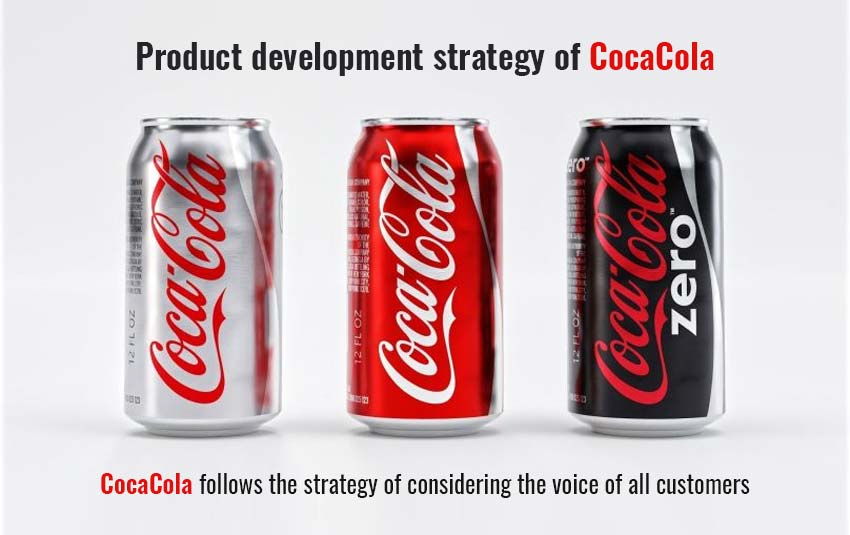
Not just this, the company also came up with small and convenient packing products to help people control their sugar intake. Thus, Coca-Cola focuses on meeting the needs of the customers in the best possible way and thus, comes up with the products that the customer wants.
Moreover, the CEO of Coca Cola, James Quincey also said “We’re listening carefully and working to ensure that consumers are firmly at the centre of our business so we can continue to grow responsibly,”
Tesla Product Development Strategy - Never launch all products at once
Tesla is an American electric car company that was incorporated in 2003 by Eberhard and Tarpenning who wanted to manufacture high-tech cars to ensure a strong brand image and popularity. But, are you aware of the fact that Tesla’s first vehicle is no longer sold in the market? Do you know the different car models of Tesla? These include Model S, X, 3, and Y. Now, you must review that since its launch, the company has manufactured various car models. But, do you know the product development strategy being adopted by Tesla for these product developments? So, let us discuss the product development strategies of Tesla.
The product development strategy of Tesla is focused on the high-end EV market where the customers are ready to pay the premium price for the products. Tesla Motors is also developing various related products such as supercharger stations to promote the demand of its new products. The focus of Tesla is not only on developing new products but is also on promoting environmental sustainability in the best possible manner. Further, you need to amaze that the long-term plan of Tesla is to create a wide range of products and accelerate the transition towards a hydrocarbon economy with the manufacturing of solar and sustainable solutions. The key product development strategy being adopted by Tesla is catering to the needs of a larger target audience. For this purpose, Tesla Motors scales up the production of affordable car models such as Model 3 and Y. The other main product development strategy of Tesla is “Never launch all products at once” as the company comes up with new car models sedately to ensure mass adoption and higher purchase intention of customers. For instance, Tesla unveiled the launch of the second-generation Roadster on November 16, 2017, with its product concept which includes a 200 kilowatt-hours battery pack, a range of 620 miles in the new model, top speed, etc. but the product deliveries are expected to start in 2022 only. The main reason behind this product development strategy is to create higher purchase intention among the customers and to generate a long list of customers waiting for the product launch.
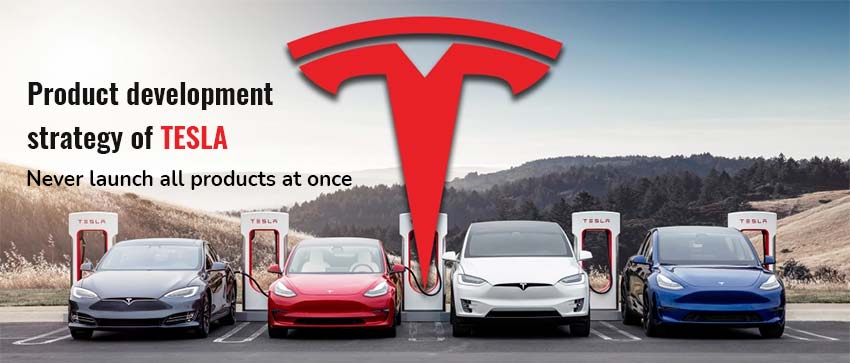
Kellogg's Product Development Strategy - Product experimentation and customer feedback
In the above sections, we discussed the different product development strategies and tactics but do you know which product development strategies Kellogg's uses? Do you know that the volume of new product launches for consumer-packed businesses is high? We can help you answer these questions by discussing the product development strategies of Kellogg’s.
Product experimentation and quick market feedback are important product development strategies of Kellogg’s by which Kellogg’s procure first-hand feedback from customers about its new products. Kellogg’s adopted the same strategy for the launch of fully recyclable paper Pringles through a partnership with Tesco in the UK. This way of learning by doing strategy is another strategy that Kelloggs uses to launch and innovate new products such as Chik'n Nuggets and Veggie Meatballs in the market. Kellogg’s also acknowledges the customer desire while launching new products. As a result, Kellogg’s came up with products like Homestyle Rice Krispies Treats, Pringles Scorchin, Eggo Stuffed Pancake Bites, etc. to meet the customer's desire for enjoyment and fun. Moreover, products like Kashi Cereal and Special K Snack bars are launched for the individuals aiming to have a Ketogenic diet. Therefore, the main product development strategies of Kellogg’s are focused on product experimentation, customer desire, and quick feedback.
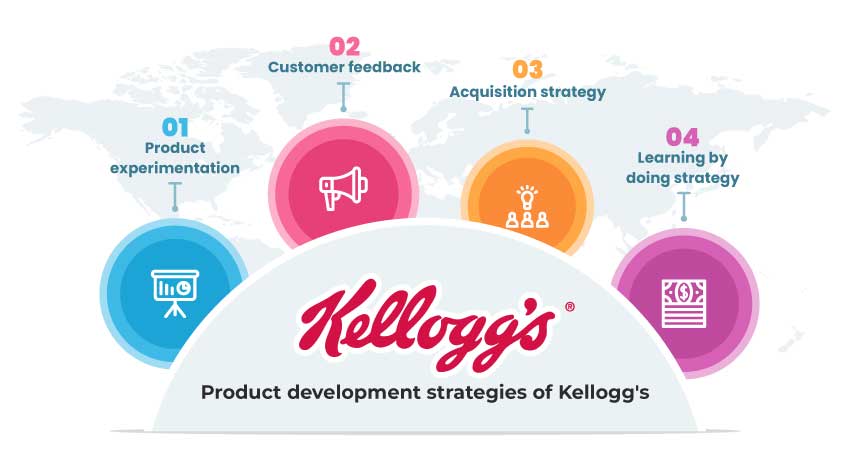
Successful product development
In the case of new product development, success cannot be measured only on the basis of the product idea as there are a number of factors that influence the success of the new product. The strategy that the organization adopts for the new product development also influences the success of the new product in the market but we need to consider that strategy is not only about product and market fit. Hence, the new product development is like “Creating something out of nothing”. So, let us talk about the keys to successful product development.
Role of the product development team in the successful launch of new product
One of the keys to the successful launch of a new product in the market is a skilled development team having knowledge and experience in the field of new product development, technologies, etc. You must be aware of the fact that creating a vision for new product development is not enough. The product development team is also responsible to turn that vision into reality. Unfortunately, it is not that simple as the product development team members also require the support of the top management team for taking approval of the new product, designing the product, and marketing it. Embracing projects with little or no support from the top management team is a recipe for the failure of the project. The key task of the product development team is to develop the product idea, product concept, prototype, and engage in test marketing before commercializing the product. This further is possible only through proper market research, concept testing, effective marketing strategies for the product, etc.
Importance of product roadmap in the successful launch of new product
Now, you have seen that having a great idea and product development team are crucial to the success of a new product but do you ever think what happens if the product roadmap is not developed or the product roadmap is unclear?
The product roadmap outlines the vision, priorities, strategies, and direction for the new product. Successful product launches are those that have a clear product road map set on the project objectives and outlines the long-term objectives and actionable outcomes. The main parts of the roadmap for new product launches include idea testing, market research, setting product price, and location, etc. The following figure illustrates the example of the product roadmap-
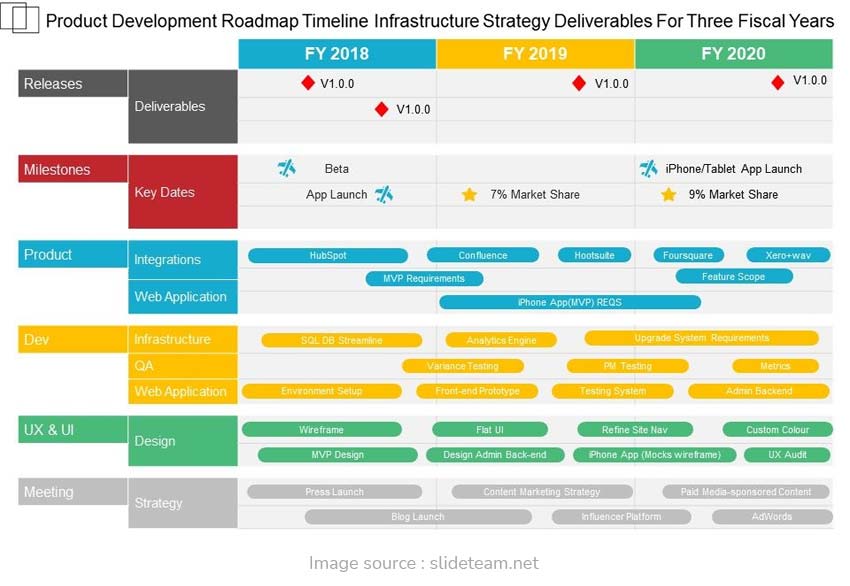
Importance of Solid research in the successful launch of new product
Now, you have identified that the product roadmap is essential to the development of new products but do you know how the product roadmap can be developed?
It is only through solid research about the target market, market needs, customer wants, unique value proposition, competitors, etc. that the product ideas can be generated and a product roadmap can be developed.
Continuing with the example of Tesla, Tesla launches a new product in the market by conducting detailed market research about the customer needs. The company also engaged in focus group discussions with females to understand the appealing features in crossover vehicles for women and to design the Model X. The Tesla Model X was introduced by incorporating women's feedback into the product design.
Importance of Thorough testing in the successful launch of new product
We need to consider the fact that the organizations are also required to engage in the thorough testing of their products to further test the product launch in the market. The testing of the new products in the market is also important to put user needs at the forefront and to ensure the success of the product in the market before product commercialization. Furthermore, Second Generation Roadster is expected to be brought into the market in 2022 but the customers can still reserve the car with the deposit of $50,000 after going through a test drive with the driver in the prototype model. The main aim of the product prototyping and test marketing of the Tesla Second Generation Roadster is to gather valuable feedback.
Importance of Timeline in the successful launch of new product
Good and successful product development projects are those that combine timelines to the product plan and roadmap. The adequate timeline helps to prepare the project milestones which also helps to create a sense of responsibility upon the project team. Moreover, the success of the new product depends on creativity and inspiration but behind all this is the need for commitment to complete everything on time.
Conclusively, there is no one factor to the success of the new product in the market but there is a broad list of factors that needs to be considered by the business firms while launching the new product in the market. After reading this informative blog, you must have got to know that product development involves the process of launching a new product in the existing market but there are various strategies and tactics that the organizations adopt while launching the new product in the market to ensure successful product launch and market growth.


